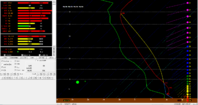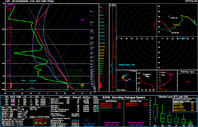I think it's important to remember that we're still looking at 60-hour forecasts at this point (12z model forecasts 2 day before the event). As such, the details *will* change. Heck, even the not-so-detailed environmental setup may change between now and the event. For example, will that part of the front in south-central KS northeastward towards Topeka be structured like a warm front slowly lifting northward (with ENE or NE winds to its north), like a cold front that's nearly stationary (with N winds to its north), or something in between? Some of the model runs have shown a nearly perfect setup for tornadic supercells in KS and OK, and those types of events don't happen very often. When the model is showing the "best", the only place for it to go is down, if you can excuse the modified trite expression.
The forecast hodographs aren't really "textbook", per se, but I'm not sure I should spend much time looking at forecast hodographs 60 hours out given that hodographs can be extremely sensitive to relatively small changes in wind speed or direction at times. However, as Kelton has shown, there are indications of suboptimal hodograph shapes -- namely, the dreaded S-shaped hodograph -- showing up in the NAM and GFS forecasts. YMMV, of course, but I have not seen a significant tornadic supercell in environments associated with S-shaped (or N-shaped) hodographs. In this particular case, the counterclockwise rotation of the local shear vector begins higher up in the troposphere than I've seen in other situations, so it's not quite as concerning. If the 700 mb flow weakens a bit more, however, we'll see hodographs more into the unfavorably-shaped regime (with negative streamwise vorticity between ~850 mb and 700 mb), which detrimentally changes the configuration of the linear dynamic component of the vertical perturbation pressure gradient field (i.e., that associated with the rotation of the shear vector with height) that can directly affect anomalous storm propagation.
Before most big tornadic supercell events, even the "best" chase days on the Plains, there are almost always some question marks and "fly in the ointment" elements. How a potential event plays out can depends upon an extremely delicate balance between highly nonlinear processes that are all but impossible to predict before the event (e.g., 6 hrs before, much less 60 hours before). At this point, the obvious signal seems to be the quasi-stationary or warm front in central and northeastern Kansas. That fact alone makes me hesitant to consider seriously that as a target area. I'm more inclined to stay ahead of the dryline in Oklahoma on the assumption that chaser convergence may be ridiculous near the front and triple point. The 12z 4 km NAM indicated a ripple on the dryline moving northward from western north TX into Oklahoma southwest and west of OKC Wednesday afternoon, which may be an interesting possibility. Of course, as noted, it's impossible to know whether such a mesoscale detail really will play out like a 54-60 hr forecast shows.


